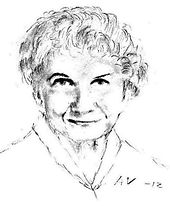Too lucky

Too much luck (in the original Too Much Happiness , 2009) is the thirteenth volume of stories by Alice Munro. Some of the works included were made freely readable online with the announcement of the Nobel Prize for Alice Munro in the version published by The New Yorker . The German translation by Heidi Zerning, published by S. Fischer in Frankfurt am Main in 2011, comprises 362 pages. The collection bears the dedication “To David Connelly”.
The irony of the title of the collection could hardly be more cruel, because the people who appear here definitely don't have to deal with too much luck. There are seven murders, one fatal car accident, deaths from various diseases, one suicide and one self-mutilation, marriages that end, and people are physically or mentally branded. It says in Peter Kemp's opening of his review of the tape in the Sunday Times in August 2009. Too much luck contains stories that come up with sensations such as double play, theft and violence. But these are little more than a prelude for subtle and far-reaching thematic reflections via reverberation, says Leah Hager Cohen in her review in the New York Times in November 2009. Even the shape of things seems to change as we read on and think about it. what we find important and why. The surprises in the development of a story initially have a destabilizing effect, after which they are confirmatory in an unexpected way. Nine of the ten works in this volume have in common that they are not set in the centers of large cities, but in suburbs or in the country. They are about how physical and subtle violence is part of everyday life, how people treat each other and life goes on anyway. Munro tell without excitement and in fine nuances of murder and manslaughter, of ignorance, helplessness, becoming guilty and defenseless. The cover story is special insofar as nothing is invented in the external data, but is based on historical facts of the life of mathematician Sofia Kowalewskaja, which begins in the 19th century in Russia and ends in Stockholm at the age of 41. In this volume, "the tone of the scenes [...] is darkened overall", there is more talk of saying goodbye, but neither the mood is gloomy nor the outlook pessimistic or melancholy. Meyer-Gosau thinks that the literary means left little doubt as to whether what is being told actually takes place as consistently as it is suggested.
The story “ Wenlock Edge ” is constructed from the narrative technique in interlocking containers (emboîtement) and is also closely related in terms of content to the Middle English work Sir Gawain and the Green Knight , writes the literary scholar Joanna Luft. Similar to Sir Gawain , the emboîtement in Wenlock Edge reveals both treacherous and complicity in relation to the relationship arrangements in which the main character himself has become involved.
Works included
- Dimensions (Dimensions, previously under the title Dimension (in the singular), version dated June 5, 2006 by The New Yorker ), p. 9
- Stories (Fiction, 2009), p. 45
- Wenlock's Ridge (Wenlock Edge, December 5, 2005 version by The New Yorker , story revised for this collection), p. 79
- Deep-Holes ( June 30, 2008 version of The New Yorker ), p. 115
- Free radicals (Free Radicals, version of 11 February 2008, The New Yorker ), p 141
- Face (Face, version September 8, 2008 by The New Yorker ), p. 167
- Some Women , p. 197
- Child's Play, p. 225
- Holz (Wood, in New Haven Review ( Memento November 2, 2013 in the Internet Archive )), p. 269
- Too Much Happiness, p. 297
- Acknowledgments, p. 365
Individual evidence
- ↑ Peter Kemp, Too Much Happiness by Alice Munro, thesundaytimes.co.uk , August 16, 2009, ( beginning of the review ).
- ↑ Leah Hager Cohen, Alice Munro's Object Lessons , nytimes.com , November 27, 2009, last accessed November 14, 2013.
- ↑ Frauke Meyer-Gosau, What people do to people. Alice Munro's new volume of short stories "Too much luck" ( memento from December 17, 2013 in the Internet Archive ), cicero.de , June 16, 2011
- ^ A b Joanna Luft, Boxed In: Alice Munro's "Wenlock Edge" and Sir Gawain and the Green Knight , in: Studies in Canadian Literature / Études en littérature canadienne , September 2010, last accessed on November 22, 2013.
- ↑ Table of Contents (PDF; 7 kB), Table of Contents (PDF; 47 kB)